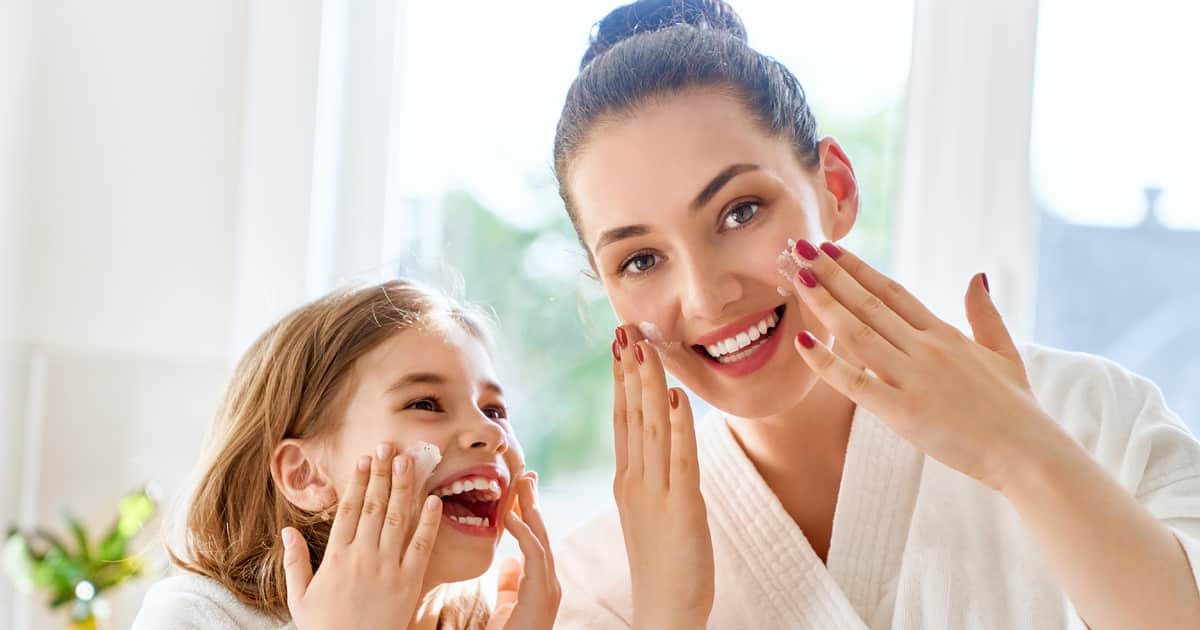The children’s skincare market in China is still in the early stages of development. Forecasts show that the market will enter a period of development in the next few years. In 2019 the market share of children’s skin care products has exceeded 13 billion yuan. It showed 20% YoY growth, comparing to 2018, increasing from 10 billion yuan in 2018. However, compared with the adult cosmetic products market in China, there is still huge room for the development of the children’s skincare market in China.
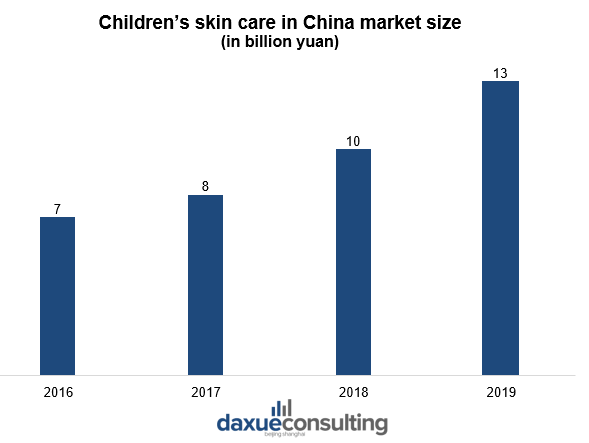
Data Source: China Research Network, Children’s skincare in China market size
Around 90% of teens in China have skin problems: acne, eczema and rashes
China Youth Daily initiated a survey of 12,117 students in 40 schools across the country focusing on teenagers’ skin conditions. The results showed that poor skin condition is the top health problem that bothered students (45%).
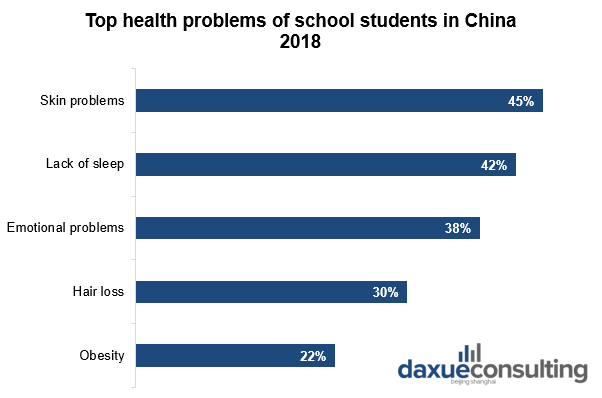
Data Source: China Youth Daily, designed by daxue consulting, top health problems of school students in China 2018, n=12,117, multiple selections allowed
Further investigation by the China Youth Daily showed that 88% of the students were more or less worried about their skin condition. The most common skin problems encountered by them are acne (63%), followed by dark circles (51%), dry skin (44%), and skin sensitivity (33%).
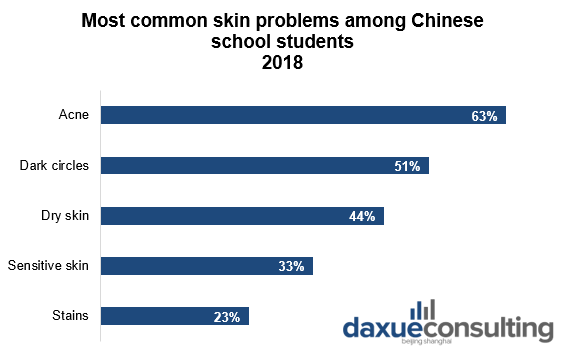
Data Source: China Youth Daily, Most common skin problems among Chinese school students 2018, n=12,117, multiple selections allowed
Some teenagers search for experiences shared by others on the Internet and buy products for treatment on their own. As a result, it causes even more problems: contact dermatitis, skin damage, and even liver and kidney function damage. In addition, some young people deal with skin problems in informal beauty institutions, which also make skin problems worse.
Eczema cases in China are rising, catching up to the west
Eczema is a common disease, which usually starts to show symptoms within two years of a child’s birth. Patients’ skin becomes itchy which sometimes influence their sleep and development if the condition is serious. The paper, published in the Journal of Allergy and Clinical Immunology, suggests environmental factors are key for eczema expression. The prevalence rate of eczema is rising worldwide, and it affects 15-30% of children and 2-10% of adults.
When it comes to eczema in China, rates of diagnosis of have been growing. The prevalence of cases in children aged 6 to 20 years was only 0.7% in 2000. However, this has risen to 8.3% by 2012 and to 13% in 2018. It is lower than the incidence in the West where prevalence is 10 to 20 percent.
There is a correlation between geographic location and eczema rates in China. Areas with warmer temperatures, higher sun exposure, and higher humidity were also associated with poor controls of the disease. As warm weather and humidity induces sweating, eczema sufferers in such areas were more likely to experience itchiness and inflammation. The simple fact that more people own air conditioning units in their homes and at work mean that eczema will not have severe symptoms.
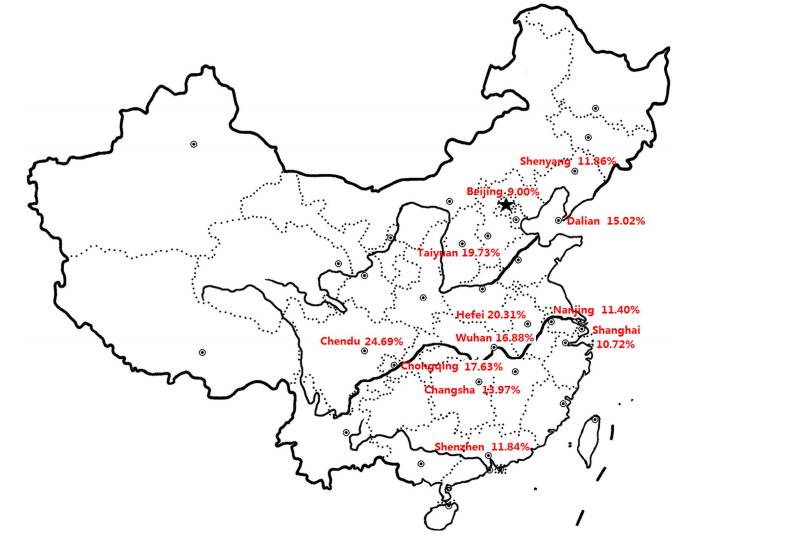
Source: Scientific Reports, Eczema prevalence of children in China
Small cities consumers starting to play bigger role in the children’s skin care market in China
According to a report by Tmall Beauty and Kantar Consumer Index, the YoY growth of skincare products consumption by “small town youths” reached 38%. The youth market in the small town is undergoing bizarre changes. On the one hand, it is infinitely close to consumption in first and second-tier cities. On the other hand, it still retains the original characteristics of Chinese rural society.
New opportunities are forming. More importantly, the information gap between first- and second-tier cities and lower-tier cities is shrinking faster. Beauty bloggers and KOLs in China help spread trends and new information. Young people in small towns have a lot of free time and are exposed to the more cost-effective products through social media such as Weibo, Xiaohongshu, and Douyin.
Growing demand for anti-acne skincare products in the teen skin care market
Since 2009, the scale of demand for anti-acne products has gradually increased every year. According to statistics, in 2018, the sales of anti-acne cosmetics in China has reached 49 million units, making China the biggest market in Asia. In addition, many people’s lives are irregular, often staying up late, and improper eating habits are prone to acne. Therefore, the teen skin care market in China is growing extremely fast and has big perspectives.
Acne skin care products are becoming the first choice for acne treatment
There is a tendency that fewer young people are choose to go to beauty salons or hospitals for acne treatment. Simple and convenient acne skin care products are the first choice for acne treatment. Therefore, anti-acne products play an important role in the teen skin care market in China.
However, for a long time, there have been three major “pain points” in China’s anti-acne products market. First, the product is not effective enough to completely remove acne. Second, the product is not up to standards, and hormones are harmful to the skin. Third, the price of anti-acne products is too high.
Chinese herbal cosmetics: a champion of acne treatment
Hengquan Group (恒泉集团) is a professional high-tech group company integrating R&D, production and sales of natural herbal cosmetics in China. It owns two manufacturing enterprises in Quanzhou, Dehua and Xiamen. Its own brand “Didou” has become the anti-acne sales champion for 17 years, creating an unprecedented miracle in the field of acne. Brand is focusing of cosmetics based on traditional Chinese medicine. As of 2012, Hengquan’s brand “Didou” has over 300 products on sale, with comprehensive acne treatment functions.
At present, Hengquan Group has more 10 wholly-owned branches, more than 100 directly-operated stores, and more than 20,000 sales terminals. It is spreading all over the country and has gradually become the leader of China’s acne treatment brands. This brand is also one of the leaders of teen skin care market in China.

Source: Taobao, Didou anti-acne essence, domestic acne care brand on the Children’s skincare market in China
Domestic and foreign cosmetic brands targeting young consumers with problematic skin
The teen skin care market in China lacks of strong brands, especially in terms of anti-acne as it is a special industry. It belongs to functional cosmetics, but China still has no special certificatation requirements, so the entry barrier is low. A large number of mixed enterprises and even individuals have come in to get a share of the pie. Therefore, the acne treatment industry is still chaotic and the market concentration is very low.
BEDOOK: a well-known brand in the teen skin care market in China
Established in 2002, BEDOOK has focused on the teen skin care market in China for 18 years. Through years of continuous testing and improvement of technology, BEDOOK formed a core advantage in the anti-acne sphere. BEDOOK is a brand that specifically targets young people and solves their skin problems. It solves the skin problems of acne, blackheads, enlarged pores, oiliness, marks and sensitivity left by acne.
In 2011, BEDOOK opened 5 Tmall stores, and has been the top seller of Taobao anti-acne products for three consecutive years. At present, BEDOOK’s sales volume in e-commerce channels is about 300 million yuan. Besides, the sales volume through offline channels reached 150 million yuan in 2018. This brand has developed into an industry giant with a volume of more than 500 million yuan per year.
The example of one of the most selling products is BEDOOK Acne Treatment Set. It includes oil-control cleansing cream, acne-stopping toner and anti-acne cream. It gained a lot of positive reviews on the Chinese e-commerce platform JD.
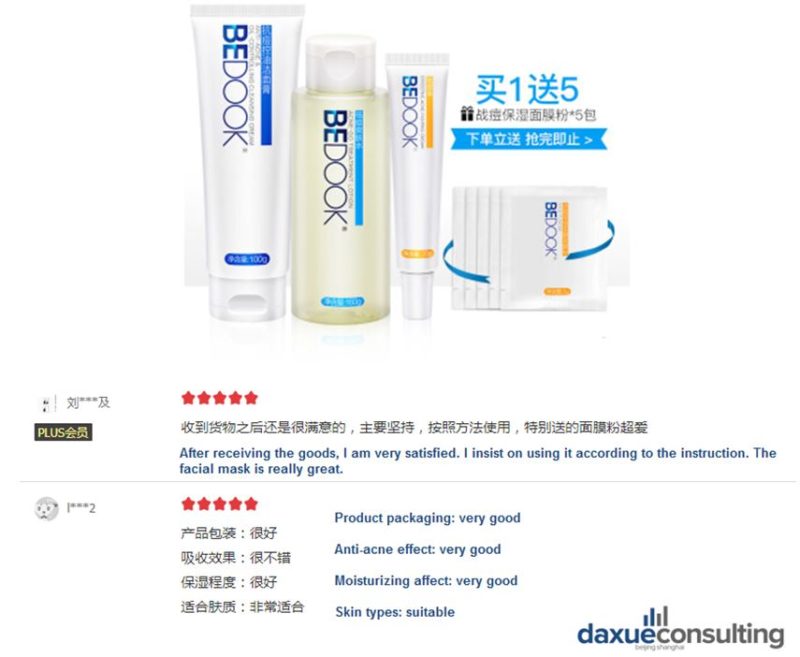
Source: JD, BEDOOK anti-acne set reviews
Clarins: helping to hide and conceal acne
Clarins is one of the leading global luxury skin care, fragrance and cosmetics companies in the world. Pioneering entrepreneur, Jacques Courtin-Clarins, founded the emblematic French brand in 1954. With an estimated valuation of $3.6 billion, the brand sells its high-quality skin care products in over 160 countries.
To complement dermatological facial treatments, Clarins has developed products to treat acne. They also help to conceal blemishes, redness and other imperfections, whilst boosting skin’s natural radiance. Acne can aggravate and weaken the skin, making it shiny and oily. Clarins’ Truly Matte range (mask, serum and lotion) hydrates the skin and tightens pores. Besides, Clarins’ Everlasting Cushion Foundation is the perfect solution for consumers looking for foolproof oil-balancing make-up. It instantly mattifies and tightens pores thanks to its plant-based ‘Skin Detox’ complex.
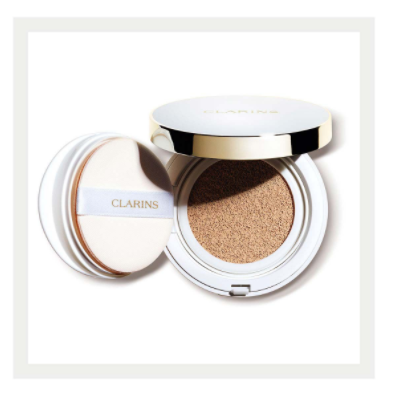
Source: Clarins, Clarins’ Everlasting Cushion Foundation
Prospect of development of the children’s skin care market in China
With the continuous expansion of market demand for skin care products, coupled with the increasingly younger age of the makeup usage, children and teen skin care market in China is growing.
The baby boom is an opportunity for the development of the children’s skin care industry. The market is large and many brands start focusing on the children’ skin care products. Some Chinese cosmetic brands are growing, and more imported children’s skin care products are trying to enter the Chinese market. At this stage, the pattern of children’s skin care market in China includes only a few brands which purely focusing on the products for children and teens. Therefore, children’s skin care market in China and teen skin care market in China have a vast opportunity for the future development.
Listen to over 100 China entrepreneur stories on China Paradigms, the China business podcast
Listen to China Paradigm on Apple Podcast



